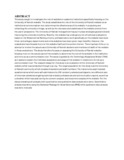| dc.description.abstract | This study sought to investigate the role of websites in academic institutions specifically focusing on the University of Nairobi website. The study establishes the role of the University of Nairobi website as an institutional communication tool, determines the effectiveness of the website in projecting and enhancing the university‘s image, as well as the relevance and usefulness of the website content from the users‘ perspective. The University of Nairobi management has put in place strategies geared towards improving the university‘s ranking. Recently, the website has undergone a lot of technical evaluations based on the Webometrics Ranking criteria, professionals to work specifically on the website have been hired, and colleges, departments and units websites have been given major facelifts. However, the evaluations have focused more on the website itself and the content therein. There has been little or no attempt to involve the actual users (University of Nairobi students and members of staff) of the website in these evaluations. This study therefore focuses on assessing the University of Nairobi website focusing more on the actual users of the website to determine the role of the website in the institution and more so as a communication tool. The study is guided by the Technology Acceptance Model (TAM) as it seeks to explain the individual acceptance and usage of the website in relations to its role as a communication tool. The research design for this study is an evaluation of the University of Nairobi website which was conducted through a survey. The target population for this study was the University of Nairobi community which consists of students and staff members. The instruments used included questionnaires which were self-administered to 200 randomly selected participants, two different sets of interview schedules targeting technical website professionals and communication experts, as well as a checklist which was used during the content analysis, and document analysis of the website. For the data processing and analysis, both quantitative and qualitative data analysis were done. Quantitative analysis was done using the Statistical Package for Social Sciences (SPSS) while qualitative data analysis was done manually | en |


